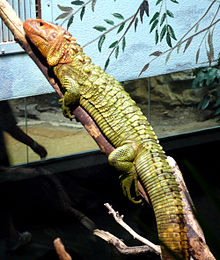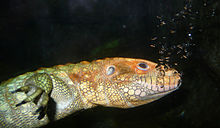- Northern Caiman Lizard
-
Northern Caiman Lizard 
Northern caiman lizard resting on branch. Conservation status Scientific classification Kingdom: Animalia Phylum: Chordata Class: Reptilia Order: Squamata Family: Teiidae Genus: Dracaena Species: D. guianensis Binomial name Dracaena guianensis
Daudin, 1802The Northern Caiman Lizard is a species of lizard found in northeastern South America.
Contents
Appearance
The Caiman Lizard is build simliarly to its cousin the tegu, with a heavy set body and short but powerful limbs. Its head is bulky and often a red or ornage color. Their jaws are heavily muscular to help aid in eatting its normal pray of snails, crawfish and fresh water clams. It also has a few adaptaions that helps it in its watery habitate. It has a long and flattened tail, similar to its name sac the Caiman. This long tail helps the Caiman Liazrd to swim and dive. It also has a clear third eyelid which is thought to act like a pair of googles underwater.
The body of the caiman lizard is very similar to that of a crocodile. Its typically a bright green with slight dark green banding. There are horned raised scales along the dorsal of the back. This help to provide some protection against predators.
These lizards can get 4 feet long and weigh close to 10lbs.
Distribution & Habitat
This species can be found in the countries of Brazil, Colombia, Ecuador, Peru, and Guyana. It lives in swampy habitats and other wooded areas which are usually flooded. It is very aquatic and an excellent climber. It spends its time basking in branches overhanging the water ways. If trouble was to arise its a quick drop into the water to safety.
The number of these lizards out in the wild is still unknown. There has not been a large study on them done in their natural habitat. Much what we know about them comes from captive animals in zoos and aquariums.
They were heavily hunted for their leather in the early 90's. In 1970 they were provided protection and the export of their hides dropped. Now local populations are safe where their habitat is protected. Captive farms have been set up to provide animals for the leather trade. In the last few years a few of these animals have found themselves in the pet trade.
Habits
The northern caiman lizard spends most of its time in or near water. At night, it hides in trees and bushes. Caiman lizards in the wild will take a variety of pray: snails, fish, crawfish, clams, invertabrate and other freshwater inhabitants all can make up a caiman lizards diet. However they do specialize in snails. It takes the snail in the jaws, raises its head up so that the prey will slide into the back of the mouth, then crushes it with its back teeth. It then spits out the pieces of shell.
In Captivity
The Caiman Lizard has been hard to keep in captivity, even most zoos have given up trying to keep these lizards. Due to their diet of snails most wild caught adults will refuse to eat anything else. Some zoos have had success in keeping and breeding them.
In the last five years, farmed baby caiman lizards from South America have made their way into the pet trade around the world. These hatchlings are more willing to except other food sources. Even so, these are not an easy lizard to keep in captivity. They have strong jaws that can cause a painful bite. The aquatic life style means they need a large pool or tank, but also need a place to dig and burrow and logs in which to bask. Their need for high humidity and hot basking temps also are hard to accommodate. Combined all that with a animal that will grow 4 feet long, its going to need a large enclosure.
That being said, some owners say there is a reward to keeping them. Caiman lizards are intelligent as can be seen in the way the approach a snail that in clinging to the rocks. They can solve problems and generally can recognize their owners.
There is a lot that still needs to be learned about this reptiles, both in captivity and in the wild.
References
- Dracaena guianensis, Reptile Database
Categories:- IUCN Red List least concern species
- Lizards
Wikimedia Foundation. 2010.


